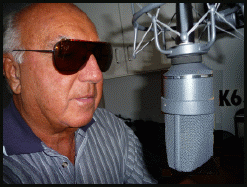 I like the shades! |
K6JRF's Page formerly W6FZC UltraWave Ultrasonic Pest Repeller |
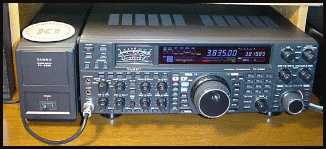
|
(Sep 7, 2019)
 I like the shades! |
K6JRF's Page formerly W6FZC UltraWave Ultrasonic Pest Repeller |

|
|
UltraWave Pest Repeller There seems to be a lot of purchasing activity these days for pest repellers. Considering the state of some of our large cities it's no wonder. With the LAX government the pest population is exploding. Nuff said! There's a number of companies selling these under different names but they all appear to be made in China and have the similar insides. One bar-owner has one of these plugged in all around his bar and tables and claims that the pests have gone away. He is very pleased. I was given a set of four (4) units and I thought that I see what the some technical measurements showed. That's the purpose of this page. |
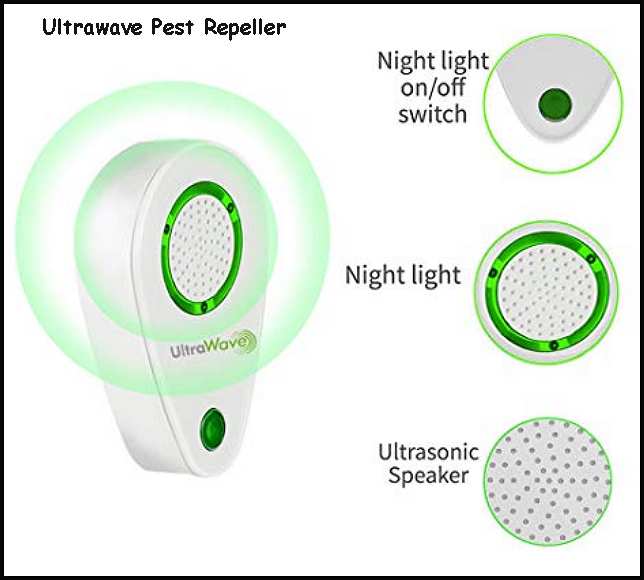
Each unit weighs a few ounces and has a 'green' colored button that turns the LED on or off. The data states that the unit operates whether the LED is on or off. Personally, I found the they make a great night lite with very low power consumption. You'll see the data later. The overall specs show operation from 90Vac to 250Vac with 50 to 60hz input. The ultrasonic output shows as 25 - 65Khz which I didn't understand b/c this was not clarified in their data supplied nor on the Amazon web site. Power consumption is "less than 5Watts". That, of course, raised my interest being quite low. The box states that you should mount the Ultrawave from 8 to 30 inches from the floor in a vertical position and keep any other object more than 40 inches away. Don't place it behind curtains. This is strange: "While the Ultrawave is functioning, do not open windows or doors for long periods. This will allow the ultrasonic wave to keep the strength and increase the efficiency. Now what is that all about??? Allow the Utrawave to work 24 hours continous per day. Measure the Power Draw . . . . 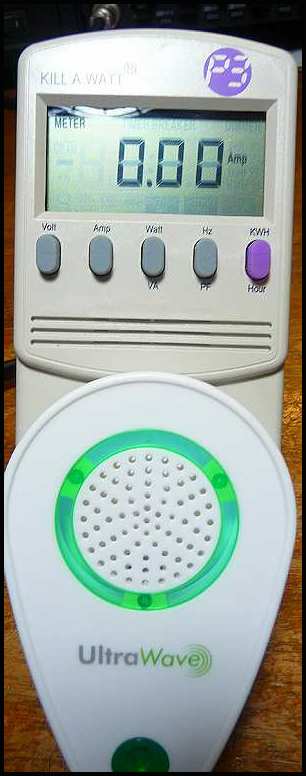
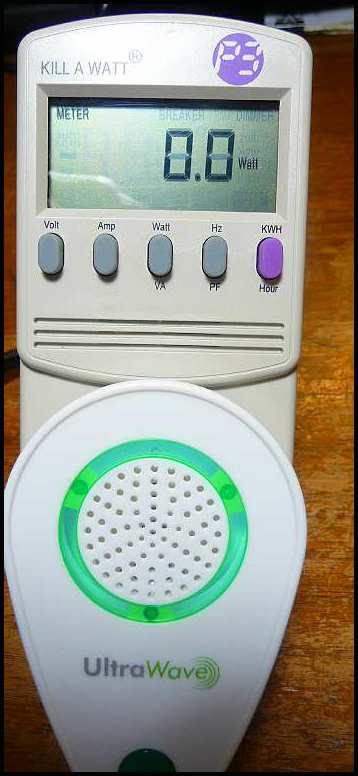 Using my Kill-A-Watt (KAW) AC Tester, I measured the AC power draw by the Ultrawave. The LEFT picture shows the AMPs being drawn
as "0" and the RIGHT shows the WATTs being used . . also "0"!! Not a good start!
Using my Kill-A-Watt (KAW) AC Tester, I measured the AC power draw by the Ultrawave. The LEFT picture shows the AMPs being drawn
as "0" and the RIGHT shows the WATTs being used . . also "0"!! Not a good start! If the unit draws 5Watts, the you would expect to see apx 0.05amps of current . . . but nothing?? Yes, I tested all four (4) units and they tested identically. |
Let's Test It . . . . 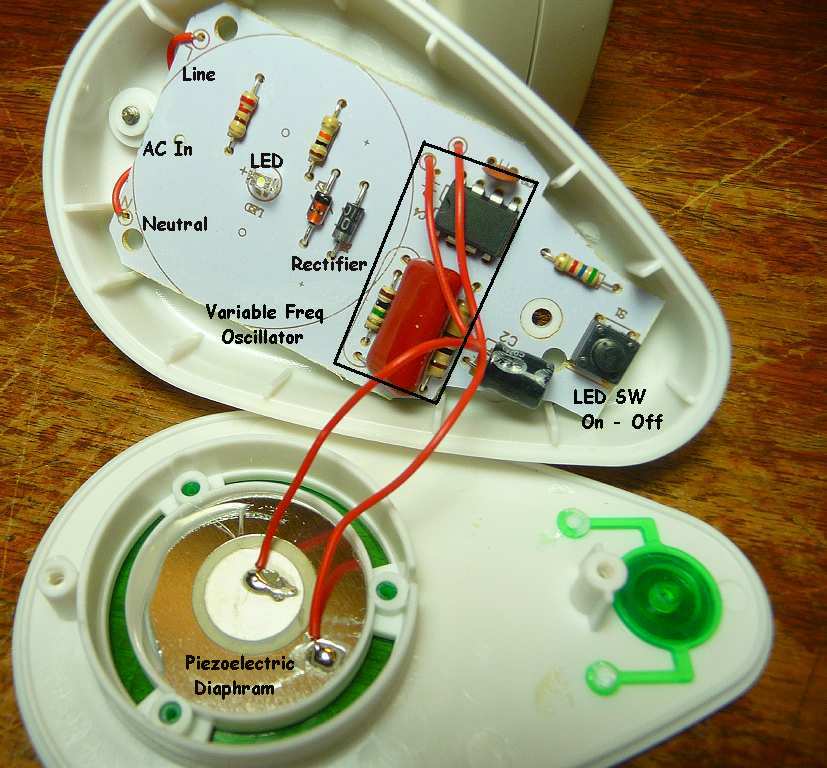 Being a pragmatic person, a guick bench test was devised. We need to open the case (two screws on the back side), remove the
front cover to expose the ckt board components and the leads to the speaker so we can measure what is happening!
Being a pragmatic person, a guick bench test was devised. We need to open the case (two screws on the back side), remove the
front cover to expose the ckt board components and the leads to the speaker so we can measure what is happening! As you can see, I've annotated so that the ckt components can be seen. It's a standard ckt where the oscillator is variable and set for the extreme ultrasonic frequencies. I didn't know this at the time, but if it output 25Khz (say) waves, then pets COULD and WOULD hear this frequency. So it had to be made to output much higher frequencies. Now the main question; how effective are these YET-UNKNOWN frequencies?? Stayed tuned. |
|
QUIMAT Q15001 Scope . . . The Quimat Q15001 scope is not a precision instrument but it's has enough bandwidth (200Khz) and high input impedance (1M ohm) to adequately measure the output level and frequency of the Ultrawave. 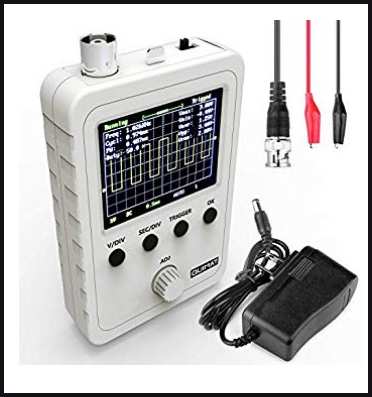
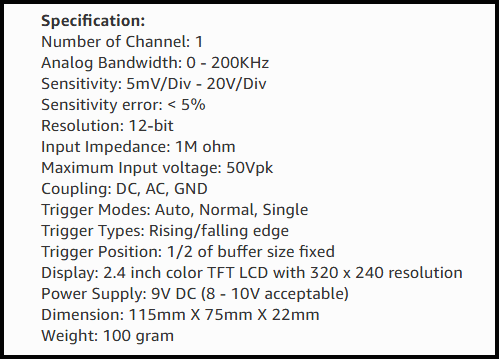
|
|
Battery Power . . . The scope runs on 9Vdc from the supplied wall-wart (120-240 to 9Vdc @ 1amp) but that limits its usefullness when you need to make some "outside" measurements on your car, for example. So a long lasting 9V battery is needed. 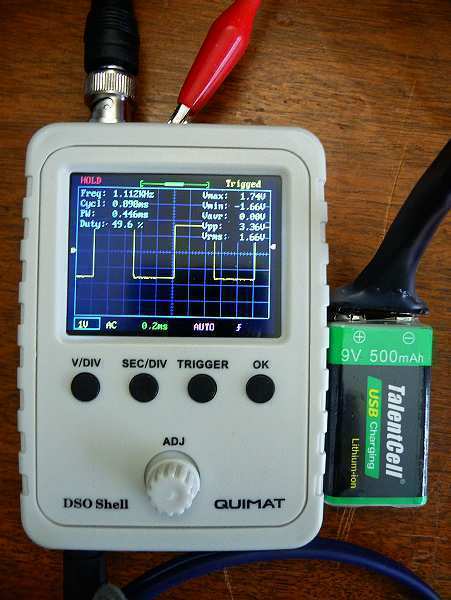
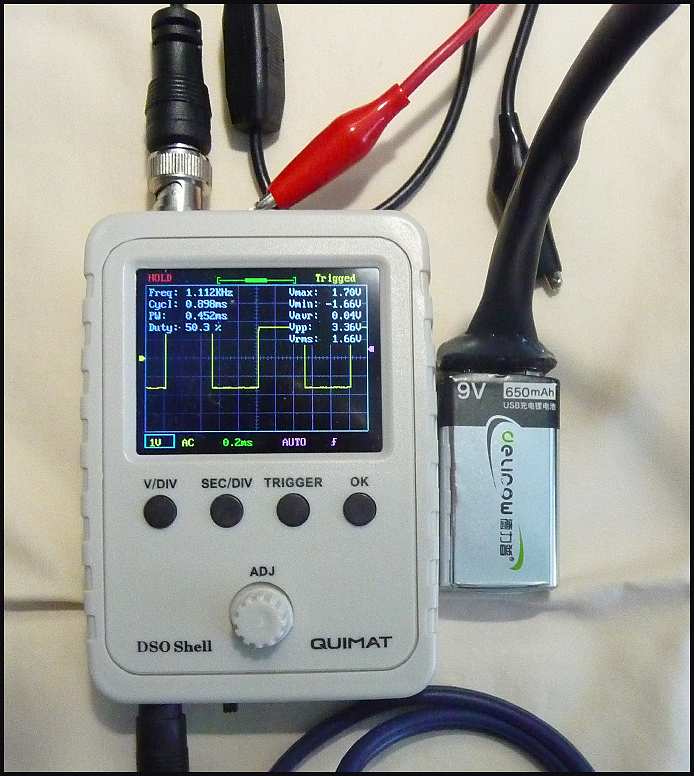 The scope's current draw is 105ma @ 9V so it should be possible to use one of the higher-power 9V @ 500mah (shown
on the left) or 9V @ 650mah (shown on the right) Li-ion battery. These batteries are the same size as an alkaline and
both have a ckt-board that controls the charging current as well as monitoring the discharge current. If the terminals are
shorted, the protective ckt 'crowbars' the output. And it charges via a micro-USB connector. The negative is that the fully
charged Li-ion battery terminal voltage is only 8.38V. A new alkaline battery produces 9.5V.
The scope's current draw is 105ma @ 9V so it should be possible to use one of the higher-power 9V @ 500mah (shown
on the left) or 9V @ 650mah (shown on the right) Li-ion battery. These batteries are the same size as an alkaline and
both have a ckt-board that controls the charging current as well as monitoring the discharge current. If the terminals are
shorted, the protective ckt 'crowbars' the output. And it charges via a micro-USB connector. The negative is that the fully
charged Li-ion battery terminal voltage is only 8.38V. A new alkaline battery produces 9.5V.
The Quimat scope requires a nominal 9V and states that it will operate from 8V to 10Vdc. I haven't tested the up-side (10V) but on the low side, it operates OK at 7.4V. Testing a new alkaline and fully charged Li-ion batteries, the scope runs for a minimum of 1-1/2hrs to a maximum of 2-1/2hrs. I'm pleased with the simple addition. Now it can be used in a portable situation w/ either an alkaline or Li-ion battery with the latter being the preference. |
Calibrator . . . 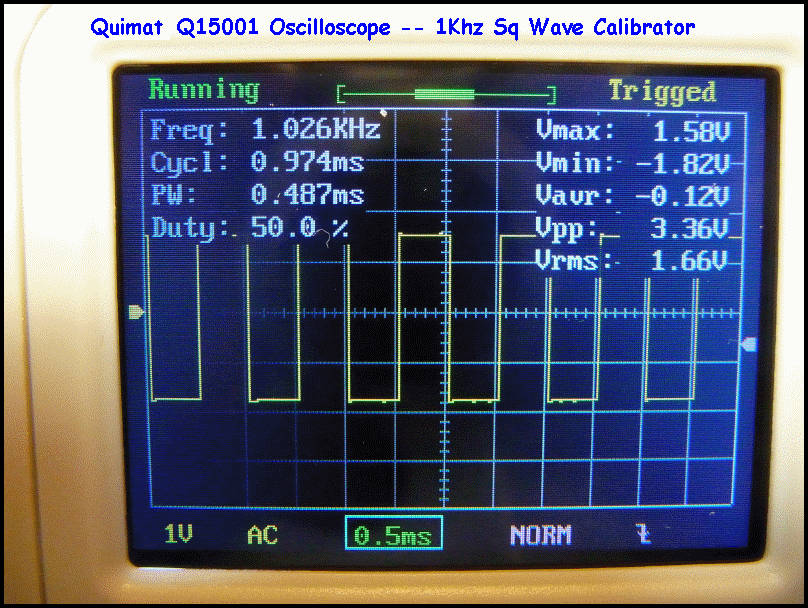 Just like the 'big-boy' scopes, it has a built-in calibrator that produces a 1Khz square wave so you can adjust the rise/fall
times and waveform symetry.
Just like the 'big-boy' scopes, it has a built-in calibrator that produces a 1Khz square wave so you can adjust the rise/fall
times and waveform symetry. The frequency is 1.026Khz w/ a duty cycle of 50%. The waveform amplitude is 3.36Vpp w/ Vrms = 1.66. Nice scope that presents all of the needed information automatically!! |
Hearing Range - Animals vs Human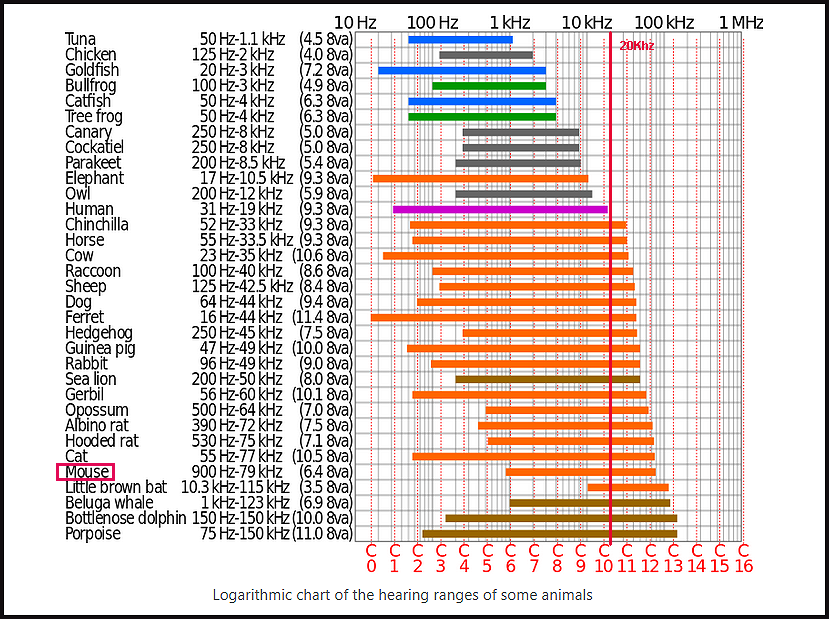 The chart on the right shows the normal hearing range for humans and various other animals. The human range is commonly given
as 20 to 20,000 Hz. Personally 20Khz is a stretch at my age as it's more like 10-12Khz. With age, there's a gradual loss of
sensitivity to higher frequencies.
The chart on the right shows the normal hearing range for humans and various other animals. The human range is commonly given
as 20 to 20,000 Hz. Personally 20Khz is a stretch at my age as it's more like 10-12Khz. With age, there's a gradual loss of
sensitivity to higher frequencies.We are interested in the hearing range for "pests" such as ants, spiders, cocroaches, etc. but you won't find any data. The chart shows what a "mouse" typically can hear. Sounds from 2Khz through 100Khz. |
Ultrawave Measurement Data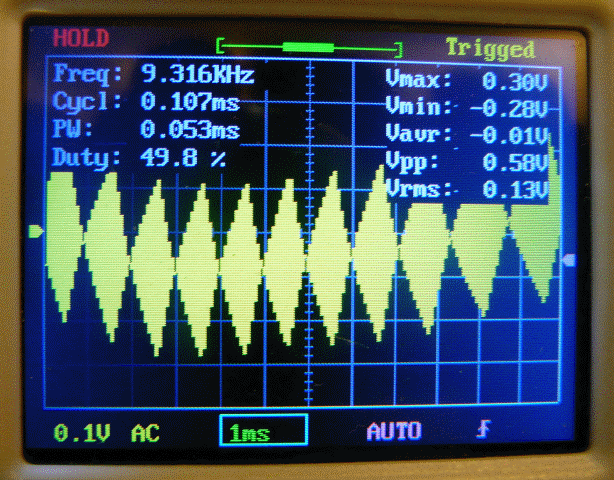
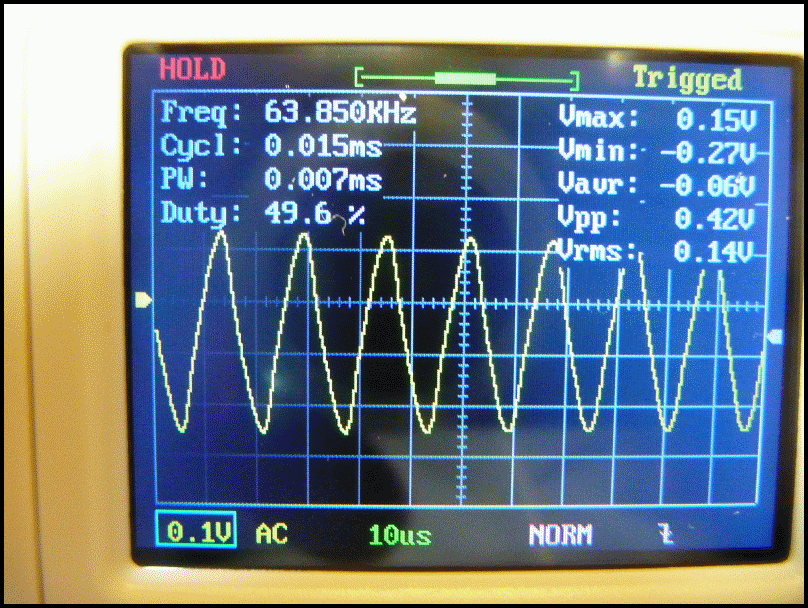 The output drive to the speaker was measured over a period of time noting that the output has two (2) modulation components;
a low frequency "triangle" modulation over the main ultrasonic frequencies.
The output drive to the speaker was measured over a period of time noting that the output has two (2) modulation components;
a low frequency "triangle" modulation over the main ultrasonic frequencies. The low freq modulation varied from apx 2Khz to 12Khz. The picture shows a scope capture at 9.3Khz. The main 'carrier' varied from apx 61Khz to 72Khz over apx 2 - 3 sec time frame. So the device produces a time changing frequency that is well above any household pet's sensitive ears! The problem is that these "Piezoelectric Diaphragms" made by Murata and others are only speced to apx 10Khz for the highest resonant frequency. So what's the impedance at 65Khz?? It's got to be HIGH . . probably 10,000 ohms or more IMO. 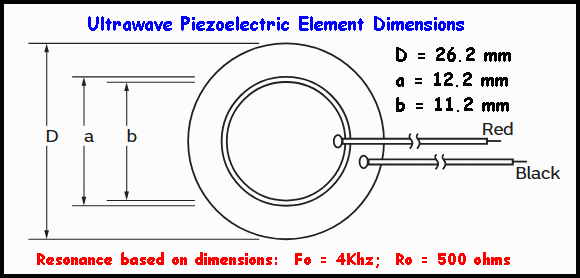 Consulting the Murata Piezoelectric Diaphram PDF, it
shows that in order to have a reasonable resonant impedance, Ro, the center element must be SMALL, apx 8-9mm as
well as the overall element dimensions being apx 12mm. Based on the Ultrawave PE element dimensions, the resonant
frequency appears to (Fo) = 4Khz at the highest and Ro = 500 ohms. Note that it's being operated well above
Fo so Ro must be greater than 10K ohms!
Consulting the Murata Piezoelectric Diaphram PDF, it
shows that in order to have a reasonable resonant impedance, Ro, the center element must be SMALL, apx 8-9mm as
well as the overall element dimensions being apx 12mm. Based on the Ultrawave PE element dimensions, the resonant
frequency appears to (Fo) = 4Khz at the highest and Ro = 500 ohms. Note that it's being operated well above
Fo so Ro must be greater than 10K ohms!When you look at the "driver", it's an UNMARKED 8pin IC which tells you that it can't produce a lot of drive power. And that is shown by the scope measurements; only apx 0.5Vpp across the speaker's impedance. That's not much power . . apx 220uW so that's not enough power to do anything IMO. So I'm not convinced. Consumer Reports stated: "Ultrasonic devices claim to emit high-frequency sounds that are too high for humans to hear but are just the right frequency to drive pests, including mosquitoes, away. The trouble is, there's no proof that they work. The Federal Trade Commission has investigated several sonic repellent makers for false advertising. In 2016, the New York Attorney General's Office sent cease and desist letters to the makers of two specific brands of sonic repellents. Numerous scientific studies show that these devices don't repel pests and may even attract them!" This is a link to a You Tube video where an intrepid user tested two (2) different ultrasonic repeller units to see if they would reduce the flying bugs . . and one grasshopper! The direct link is here. To be fair, here's link showing what I think is an effective mouse/rat repeller. If you look carefully, they are not panicked but are definitely not happy. Thus the climbing and trying to look for an exit. IMO, this one works . . direct link is here. Here's another video showing the "ADEON" unit being tested and bench analysis. The reviewer shows that this unit is available on Amazon. If you click, you'll see that the ADEON unit is now called "YOOKOON" . . no more ADEON!! That should tell you something, don't you think?? The video is here. As stated, the Ultrawave Pest Repeller is designed for "small" pests: ants, flies, bettles, cockroaches, spiders, mouse, rats, etc. I don't know if this frequency band is effective but based on the large amount of positive user feedback, these things seem to work well. My comment: If the power output is "reasonable", say 100mW or so, then it's possible that an ultrasonic unit could reduce the pest population. I've have no conclusions to the effectiveness in my house since I just got rid of the "ants" in the old-fashioned method . . chemicals!! Killed a colony of at least 20,000 ants which had been all over my home for the last 5+ years! |